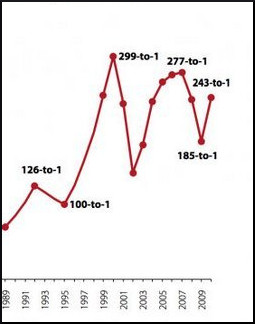
For the Christian Science Monitor, staff writer Schuyler Velasco compiled a list of the American corporations where the yawning abyss between CEO pay and employee pay is most apparent. For every dollar the average McDonald’s employee makes, CEO Donald Thompson takes home 1,196 of them. How is it possible that any human being’s time is worth more than a thousand times as much as the time of another human being?
Existential questions aside, McDonald’s is the most egregious example of ridiculously munificent executive compensation, followed by Starbucks and Dollar General. Among the top 10, the least discrepancy is found at AT&T, where the biggest boss makes only 558 times the wage of an average worker.
Ratcheting up Salaries
For Dissent Magazine, Colin Gordon explains the process of deciding how much to pay a bigwig. A show of detached neutrality is made by deferring to the wisdom of a “compensation committee.” The members are other bigwigs with similar job descriptions. Next week, one of those execs will be up for a raise, and guess who will be on his compensation committee? That’s right — the very same guy whose salary he is deciding today. Gordon says:
These compensation committees […] have perfected a machine for ratcheting up executive pay. As a general rule, CEO pay is calculated from a benchmark of peers. The result is a lucrative game of leapfrog. The selection of peers is arbitrary — and often consists of cherry-picking larger and successful firms with higher-paid executives.
In effect — with very limited input from shareholders and no demonstrable connection to firm performance — top executives set their own salaries.
Shareholders Lack Clout
Supposedly, performance-based pay is subject to shareholder approval, and a reasonable person might ask, “Why don’t they take charge, and rein in these greed-heads?” But as it turns out, the deck is stacked. The system contrives to make shareholder influence largely theoretical. Their role is purely advisory and the corporation doesn’t have to do what they recommend.
For a giant business with high-powered lawyers on retainer, it is very easy to circumvent any rule. The corporate entity can hide, even from its own stockholders, exactly what is going on, in what Gordon calls “a concerted effort to camouflage the level and terms of executive pay packages with various forms of stealth compensation (such as lavish retirement deals) or rigged performance measures (such as stock options).” Even worse, there are two classes of shareholders. Gordon says:
Increasingly, shareholding is dominated by the block holdings of big institutional investors (mutual funds, pension funds, and the like). And many public firms use ‘dual class’ shares to distribute voting rights more narrowly than stock ownership.
Stockholding citizens, even the most socially conscientious, have very little clout. And what do the execs get paid for? Who knows, but it’s a pretty sure bet they are not busy figuring out how to reduce the income gap, and pay enough so that none of their employees need to apply for government relief.
Universal Living Wage
Eleanor Bloxham, CEO of The Value Alliance and Corporate Governance Alliance, believes that a company should be transparent about whether it pays a living wage to every person who works for it. For a recent Fortune CNN article, she quoted House the Homeless President Richard R. Troxell about the Universal Living Wage concept, so please go and take a look.
Also, please remember Economic Gap Day is coming up on Tuesday, September 2. Everyone is urged to organize or join a demonstration in a highly visible public place. Check out this video of a past Economic Gap Day to catch the vibe:
The Universal Living Wage means basic food, clothing, shelter (including utilities), public transportation, and access to an emergency room! This must be the minimum standard for every American and all people.
Reactions?
Source: “CEO Vs. Worker Pay: Walmart, McDonald’s, and Eight Other Firms With Biggest Gaps,” CSMonitor.com, 12/12/13.
Source: “Fatter Cats: Executive Pay and American Inequality,” DissentMagazine.org, 04/24/14.
Source: “Inequality in the U.S.: Are We Making Any Progress?” Fortune.com, 08/04/14.
Image by Devendra Makkar.0


